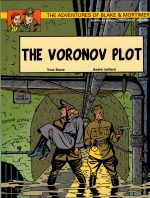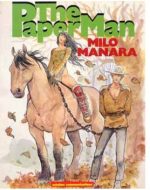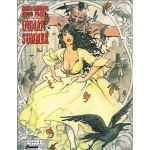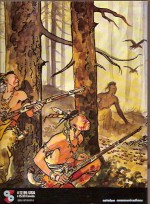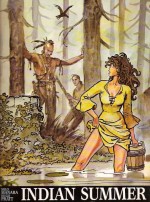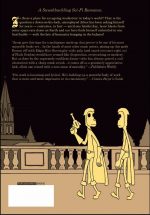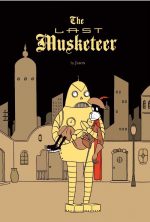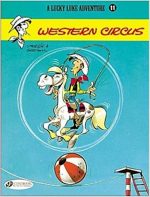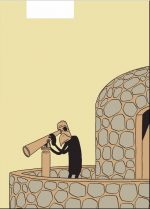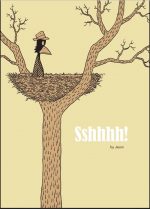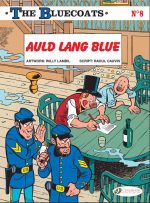
By Willy Lambil & Raoul Cauvin translated by Jerome Saincantin (Cinebook)
ISBN: 978-1-84918-245-4
Les Tuniques Bleues began in 1968; an occasional comedy western strip created by Louis “Salvé†Salvérius & Raoul Colvin – who has solo-written every best-selling volume since. The feature was created to replace Western wonder man Lucky Luke when the laconic lone gunslinger defected from weekly anthology Spirou to comic rival Pilote.
His rapidly-rendered replacements swiftly became one of the most popular bande dessinée stars on the Continent…
Salvé was a cartoonist of the Gallic big-foot/big-nose humour style, and when he died suddenly in 1972, his replacement – Willy “Lambil†Lambillotte – gradually moved to a more edgy and realistic (although still broadly comedic) illustrative manner. Lambil is Belgian-born (in 1936) and, after studying Fine Art in college, joined publishing giant Dupuis as a letterer in 1952.
Born in 1938, scripter Raoul Cauvin is also Belgian and studied Lithography before joining Dupuis’ animation department in 1960. He soon discovered his true calling as a comedy writer and began a glittering and prolific career at Spirou.
In addition to Bluecoats Cauvin has written dozens of other long-running, award winning series including Cédric, Les Femmes en Blanc and Agent 212: amassing more than 240 separate albums in total. The Bluecoats alone have sold more than 15 million copies worldwide.
The sorry protagonists of the show are Sergeant Cornelius Chesterfield and Corporal Blutch, a pair of worthy fools in the manner of Laurel and Hardy: hapless, ill-starred US cavalrymen posted to the wild frontier and various key points of mythic America.
The original format was single-page gags about an Indian-plagued cavalry fort, but with second volume ‘Du Nord au Sud’ (North and South) the sad-sack soldiers went back East to fight in the American Civil War.
That origin was discarded and rewritten a decade later, finally and canonically describing how the chumps were drafted into the military during the war and appears here as Auld Lang Blue: Cinebook’s 8th astoundingly attractive Bluecoats album.
All subsequent adventures – despite ranging far beyond the traditional environs of America and taking in a lot of genuine and thoroughly researched history – are set within the timeframe of the Secession conflict.
Blutch is your average whinging little-man-in-the street: work-shy, mouthy, devious and especially critical of the army and its inept commanders. Ducking, diving, feigning death and even deserting whenever he can, he’s you or me – except sometimes he’s quite smart and heroic if no other, easier, option is available.
Chesterfield is a big burly man; an apparently ideal career soldier who has passionately bought into all the patriotism and esprit-de-corps of the Military. He is brave, never shirks his duty and wants to be a hero. He also loves his cynical little pal. They quarrel like a married couple, fight like brothers but simply cannot agree on the point and purpose of the horrendous war they are trapped in…
But as this witty yarn elaborates, such was not always the case…
Les Tuniques Bleues: Blue rétro was first seen on the continent in 1980, serialised in Spirou #2222-2232. It was the unlikely lads’ 29th adventure, and became the 18th best-selling collected album a year later (of 58 and counting, thus far).
It opens here as dutiful son Cornelius is awakened by his doting but domineering mother. She’s thoroughly excited by her boy’s upcoming nuptial merger with butcher’s daughter Charlotte Graham. Bewildered Cornelius still can’t work how, let alone why, he’s all-but-inescapably betrothed to his boss’ far from comely child…
The boy’s rowdy, wheelchair-bound dad Joshua Chesterfield is less cheery. He fondly remembers his military years and, as a proud survivor of the Alamo, wishes his son had more gumption and get-up-and-go…
There’s no winning against his mother though, so Cornelius heads for the butchers’ shop, arriving just in time to deftly avoid Charlotte by delivering a large order to the new Pacific Bar that has just opened on Main Street. The little guy behind the gleaming bar is a bit of an annoyance but young Chesterfield’s initial distaste is soon swallowed up by the chatter of the patrons discussing the Secession War.
The Northern States are taking a terrible beating on all fronts, but neither butcher’s boy or barman care all that much about a subject so far removed from their own lives…
That quickly changes after Army Recruiters proudly parade their latest crop of raw material down the thoroughfare. Diminutive, canny Blutch is bemused, but Cornelius sees glory, adventure and escape from matrimonial servitude in the gleaming column of callow blue boys…
All the same, mother and Mr. Graham have Cornelius’ life utterly mapped out, and despite his fervent desires, soon after Cornelius M. Chesterfield is all dandied-up and despatched to make a formal proposal to Charlotte. Unwilling, unhappy and contemplating years of being bossed around by women, Cornelius stops off at the Pacific Bar to intestinally fortify himself before the ordeal.
Being a comradely, consoling type, barman Blutch keeps him company in a tot or two and they are both extremely amenable when – some hours later – the Army Recruiters enter the bar. Joining the festivities, the soldiers soon realise that their still woefully-unfilled quotas might benefit from a bit of blather and a couple of hastily modified application forms…
And so it begins: by the time they are conscious again our two new warriors are well on the way to becoming infantrymen: each adapting to the appalling situation in their own unique manner as they reluctantly adjust to the daily madness of army life.
However, even before basic training is over, they both realise their lives are now governed by elitist idiots who don’t care if they live or die. Unable to avoid being cannon-fodder, they conspire to transfer into the far safer and more glamorous cavalry. All they need to do now is learn to ride before anyone finds out they don’t know one end of a horse from the other…
Historically authentic, always in good taste despite its uncompromising portrayal of violence, the attitudes expressed by the down-to-earth pair never make battle anything but arrant folly and, like the hilarious yet insanely tragic war-memoirs of Spike Milligan, these are comedic tales whose very humour makes the occasional moments of shocking verity doubly powerful and hard-hitting.
This particular tome is heavy on comedy too: a fun, informative, beautifully realised and eminently readable yarn to appeal to the best, not worst, of the human spirit.
© Dupuis 1981 by Lambil & Cauvin. English translation © 2015 Cinebook Ltd. All rights reserved.

